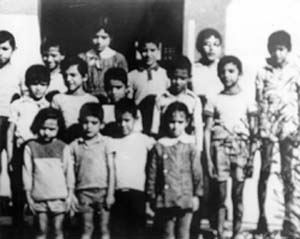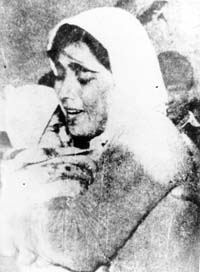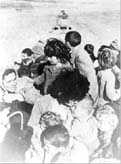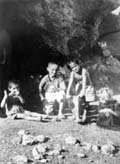early history
1964-1974
after 1974
Articles
Rauf R. Denktash
Necati M. Ertekun
Fusun C. Doskaya
World Press
Documents
U.N. Resolutions
London-Zurich Treaties
Makarios' "13 points"
The Akritas Plan
The
political conflict between the two communities on the island began in
1878, when Greek Cypriots desired ENOSIS (
However,
shortly after the founding of the Republic, serious differences arose
between the two communities about the implementation and interpretation of
the constitution. The Greek Cypriots argued that the complex mechanisms
introduced to protect Turkish Cypriot interests were obstacles to
efficient government. On
On

A Turkish woman with her three children killed mercilessly by Greek Cypriot gunmen in Lefkosa, in 1963.
Although
the Republic of Cyprus, founded in 1960, ended in 1963, when the Greek
organs of government, administration and legislation proceeded to
disregard the Turkish participatory rights as guaranteed by the
Constitution of 1960, in the same resolution mentioned above (Resolution
186 of 1964), UN Security Council referred to the Government of Cyprus in
a way which implied that the government manned only now by the Greek
Cypriots, was the legitimate Government of Cyprus. Since then, the Greek
Cypriots continue to usurp the titles of the bi-communal state. In fact,
they are ‘the government of a state whose territory is restricted to the
southern part of
when
between 1963 and 1974, Greek organs of the Republic of Cyprus and parts
thereof and new organs founded by these or by Greek Cypriots, seized power
over a part of the island’s territory in a revolutionary process. They
ceased to recognize fundamental parts of the Constitution of Cyprus of
1960 and ...separated themselves, and the Greek community from the
Unfortunately,
the arrival of UNFICYP did not prevent Greek attacks on Turkish Cypriots
and 1964-1974 period had been a harsh period for the Turkish side. For
them, those years were marked by injustice, oppression, violence and
discrimination. In 1967, the situation deteriorated, when a military junta
seized power in
All
these events forced the Turkish Cypriots to organize their own national
administration and this resulted in establishing the provisional Turkish
Cypriot Administration, on
In
1974, the attempted genocide against the Turkish Cypriots was repeated
once more. On

These happy children once attending the joint primary school of Murataga (Maratha), Sandallar (Sandallaris) and Atlilar (Aloa) in Famagusta Area do not live any more. They were massacred, with their families, by Greek Cypriot armed elements and buried into mass-graves in 1974. Had Turkey not acted this time, this annihilation would have been extended to the rest of the Turkish Cypriot Community in Cyprus. Thus the Turkish Army clearly averted a wholesale genocide of the entire Turkish community.
"Greece-Cyprus-Enosis"
Makarios himself took part in the armed attacks against Turkish Cypriots in 1964
A Turkish woman with her three children killed mercilessly by Greek Cypriot gunmen in Lefkosa, in 1963.

Little babies
are riddled with bullets by armed Greek Cypriots, and many left with no
milk during 1964-74 period


Turkish Cypriots fleeing from their homes as a result of Greek Cypriot armed attacks in 1964 and also were forced to live in caves by EOKA, in 1964